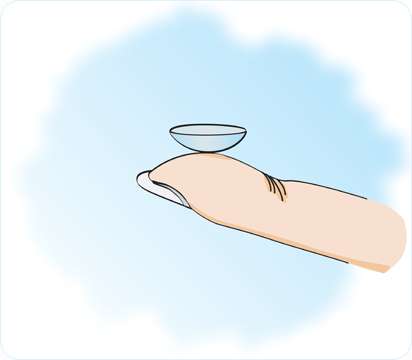ARE THEY SUITABLE FOR ME?

Contact lens technology is ever evolving with advancements in materials meaning they are now more comfortable than ever and available to suit pretty much anyone that wants to try them. You may have been told previously that you weren’t suitable for contact lenses or you simply didn’t like how they felt in your eyes. Maybe it’s time to make the enquiry and revisit the world of disposable contact lens wear. For those who have never tried, here is a brief run down of what’s available.
Contact lenses come in two main types – soft contact lenses and hard contact lenses. Soft lenses are made from soft plastic and are more common as they are more comfortable and more accessible than hard lenses. Hard lenses or rigid permeable lenses (RGP) are made from hard plastic and are more suited for specific eyes that need a bit more help, such as high astigmatism or for people that have corneal issues such as keratoconus.
HOW LONG CAN I WEAR CONTACT LENSES FOR?
With soft contact lenses, the main types are daily disposables, fortnightly disposables or monthly disposable lenses.
Daily disposable contact lenses: Daily disposables are used for one day only, you put them in the morning and throw them out in the evening. These are convenient as you don’t need to clean and disinfect them, and are more suited to people that only want to wear contact lenses occasionally (around 4 days a week or less).
Fortnightly/Monthly disposable contact lenses: Fortnightly or monthly disposable lenses last either 2 weeks or 1 month and come in greater parameters in terms of prescription and sizing. You still need to remove them every night and an extra step involved is a quick clean and disinfect before storing them in a contact lens case.
For specific people, extended wear contact lenses are also available, where you can leave the contact lens in your eye for up to a month without removal. There are only a handful of these types in the soft contact lens market, but are great for patients that do night shift work. It is always advisable to remove your contact lenses before sleeping, as the risk of getting an eye infection and permanent vision loss is a lot greater when you sleep with contact lenses in.
CAN I GET THEM IN MY PRESCRIPTION?
Contact lenses can fit a wide range of prescriptions, whether you need them as single vision, for astigmatism and they are also available in Multifocals. We have different methods to achieve the best fit, comfort and optical clarity whilst also making sure the contact lens sits correctly on your eye to minimise irritation.
WHY DO I NEED MY CONTACT LENSES FITTED BY AN OPTOMETRIST?
It is important to get your contact lenses correctly fitted by a professional Optometrist as an ill-fitting lens that is too tight, too loose, too wide or too narrow can have implications on your eye health (think of it like a shoe – but for your eyes, which is a more delicate part of the body). A correctly fitted contact lens should not rub on your eye causing scratches, nor should it move around too much to get out of position and affect your vision. Your contact lenses should always feel comfortable.
There are many different reasons why people opt for contact lenses. Whether it be to be free from the weight of glasses sitting on your face, for freedom when doing active sports and activities to the option of changing up your appearance. We have fitted contact lenses from a wide range of ages, all the way from 8 to 75+ so age is no barrier.
If you have any questions or would like to try contact lenses please call 02 88147450 or book an appointment online https://kellyvilleoptical.com.au/book/

